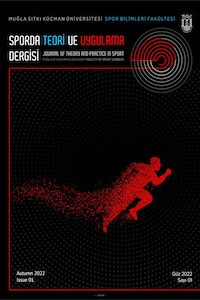A study of lower-limb bilateral and unilateral strength asymmetry in Maltese sprinters using the modified sphygmomanometer test
Unilateral asymmetry, bilateral asymmetry, Maltese sprinters, modified sphygmomanometer test
A study of lower-limb bilateral and unilateral strength asymmetry in Maltese sprinters using the modified sphygmomanometer test
Bilateral asymmetry unilateral asymmetry, Maltese sprinters, lower-limb, modified sphygmomanometer test,
___
- Alt, T., Heinrich, K., Funken, J., & Potthast, W. (2015). Lower extremity kinematics of athletics curve sprinting. Journal of Sports Sciences, 33(6), 552-560.
- Beato, M., Young, D., Stiff, A. and Coratella, G. (2021) Lower-limb muscle strength, anterior-posterior and inter-limb asymmetry in professional, elite academy and amateur soccer players. Journal of Human Kinetics, 77(21) 135-146.
- Beukeboom, C., Birmingham, T. B., Forwell, L., & Ohrling, D. (2000). Asymmetrical strength changes and injuries in athletes training on a small radius curve indoor track. Clinical Journal of Sport Medicine, 10(4), 245-250.
- Bishop, C., Read, P., Chavda, S., & Turner, A. (2016). Asymmetries of the Lower Limb. Strength and Conditioning Journal, 38(6), 27–32.
- Chang, Y. H., & Kram, R. (2007). Limitations to maximum running speed on flat curves. Journal of Experimental biology, 210(6), 971-982.
- Coombs, R., & Garbutt, G. (2002). Developments in the use of the hamstring/quadriceps ratio for the assessment of muscle balance. Journal of sports science & medicine, 1(3), 56.
- Coratella, G., Beato, M., & Schena, F. (2018). Correlation between quadriceps and hamstrings inter-limb strength asymmetry with change of direction and sprint in U21 elite soccer-players. Human Movement Science, 59, 81–87.
- Dow Morrison, F. N., Ashworth, B., & Kaveney, T. T. (2020). The validity of the sphygmomanometer for shoulder strength assessment in amateur rugby union players. Physical Therapy in Sport.
- Fort-Vanmeerhaeghe, A., Gual, G., Romero-Rodriguez, D., & Unnitha, V. (2016). Lower limb neuromuscular asymmetry in volleyball and basketball players. Journal of Human Kinetics, 50(1), 135-143.
- Fousekis, K., Tsepis, E., & Vagenas, G. (2010). Lower limb strength in professional soccer players: profile, asymmetry, and training age. Journal of sports science & medicine, 9(3), 364.
- Girard, O., Brocherie, F., Morin, J. B., & Millet, G. P. (2017). Lower limb mechanical asymmetry during repeated treadmill sprints. Human movement science, 52, 203-214.
- Helewa, A., Goldsmith, C. H., & Smythe, H. A. (1981). The modified sphygmomanometer—An instrument to measure muscle strength: A validation study. Journal of Chronic Diseases, 34(7), 353–361.
- Helme, M., Tee, J., Emmonds, S., & Low, C. (2021). Does lower-limb asymmetry increase injury risk in sport? A systematic review. Physical Therapy in Sport, 49, 204–213.
- Impellizzeri, F. M., Rampinini, E., Maffiuletti, N. & Marcora, S. M. (2007). A vertical jump force test for assessing bilateral strength asymmetry in athletes. Med Sci Sports Ex, 39, 2044– 2050.
- Ishimura, K., & Sakurai, S. (2016). Asymmetry in Determinants of Running Speed During Curved Sprinting. Journal of Applied Biomechanics, 32(4), 394–400. Mondin, D., Owen, J. A., Negro, M., & D’Antona, G. (2018). Validity and reliability of a non-invasive test to assess quadriceps and hamstrings strength in athletes. Frontiers in Physiology, 9, 1702.
- Morin, J. B., Gimenez, P., Edouard, P., Arnal, P., Jiménez-Reyes, P., Samozino, P., Brughelli, M. & Mendiguchia, J. (2015). Sprint acceleration mechanics: the major role of hamstrings in horizontal force production. Frontiers in physiology, 6, 404.
- Nunn, K. D. & Mayhew, J. L. (1988). Comparison of three methods of assessing strength imbalances at the knee. J Orthop Sports Phys Ther, 6, 134–137.
- Pandy, M. G., Lai, A. K., Schache, A. G., & Lin, Y. C. (2021). How muscles maximize performance in accelerated sprinting. Scandinavian Journal of Medicine & Science in Sports, 31(10), 1882-1896.
- Pietraszewski, P., Gołaś, A., Matusiński, A., Mrzygłód, S., Mostowik, A., & Maszczyk, A. (2020). Muscle Activity Asymmetry of the Lower Limbs During Sprinting in Elite Soccer Players. Journal of Human Kinetics, 75(1), 239-245.
- Rutkowska-Kucharska, A. (2020). Asymmetry of lower limb strength and jumping ability of young soccer players. Acta of Bioengineering and Biomechanics, 22(1).
- Sannicandro, I., Piccinno, A., Rosa, R. A., & De Pascalis, S. (2011). Functional asymmetry in the lower limb professional soccer players. British Journal of Sports Medicine, 45(4), 370–370.
- Sannicandro, I., Cofano, G., Rosa, A. R., Traficante, P., & Piccinno, A. (2017). Functional movement screen and lower limb strength asymmetry in professional soccer players. British Journal of Sports Medicine, 51(4), 381-382.
- Souza, L. A. C. e, Martins, J. C., Teixeira-Salmela, L. F., Godoy, M. R., Aguiar, L. T., & Faria, C. D. C. de M. (2013). Avaliação da força muscular pelo teste do esfigmomanômetro modificado: uma revisão da literatura. Fisioterapia Em Movimento, 26(2), 437–452.
- Tatlıcıoğlu, E., Atalağ, O., Kırmızıgil, B., Kurt, C., & Acar, M. F. (2019). Side-to-side asymmetry in lower limb strength and hamstring-quadriceps strength ratio among collegiate American football players. Journal of Physical Therapy Science, 31(11), 884–888.
- Zahálka, F., Malý, T., Malá, L., Gryc, T., & Hráský, P. (2013). Power assessment of lower limbs and strength asymmetry of soccer goalkeepers. Acta Gymnica, 43(2), 31-38.
- Başlangıç: 2022
- Yayıncı: Mugla Sitki Kocman University
Teaching Handball Game Rules with Computer Simulation
Kevin Hamza MAGRO, Matthew MUSCAT-INGLOTT
Yavuz ÖNTÜRK, Damla ÖZSOY, Sinan Erdem SATILMIŞ, Abdurrahman YARAŞ
The Association of Physical Activity, Sports Participation and BMI with Academic Performance.
Alessio MAGRO, Renzo KERR-CUMBO, Ayrton ZARB
Pliometrik antrenmanın bibliyometrik veriler ile değerlendirilmesi: Bir tanımlayıcı çalışma
Hüseyin Şahin UYSAL, Seda Nur UYSAL
Investigation of Injury Anxiety of Sports Sciences Faculty Students in Terms of Some Variables
